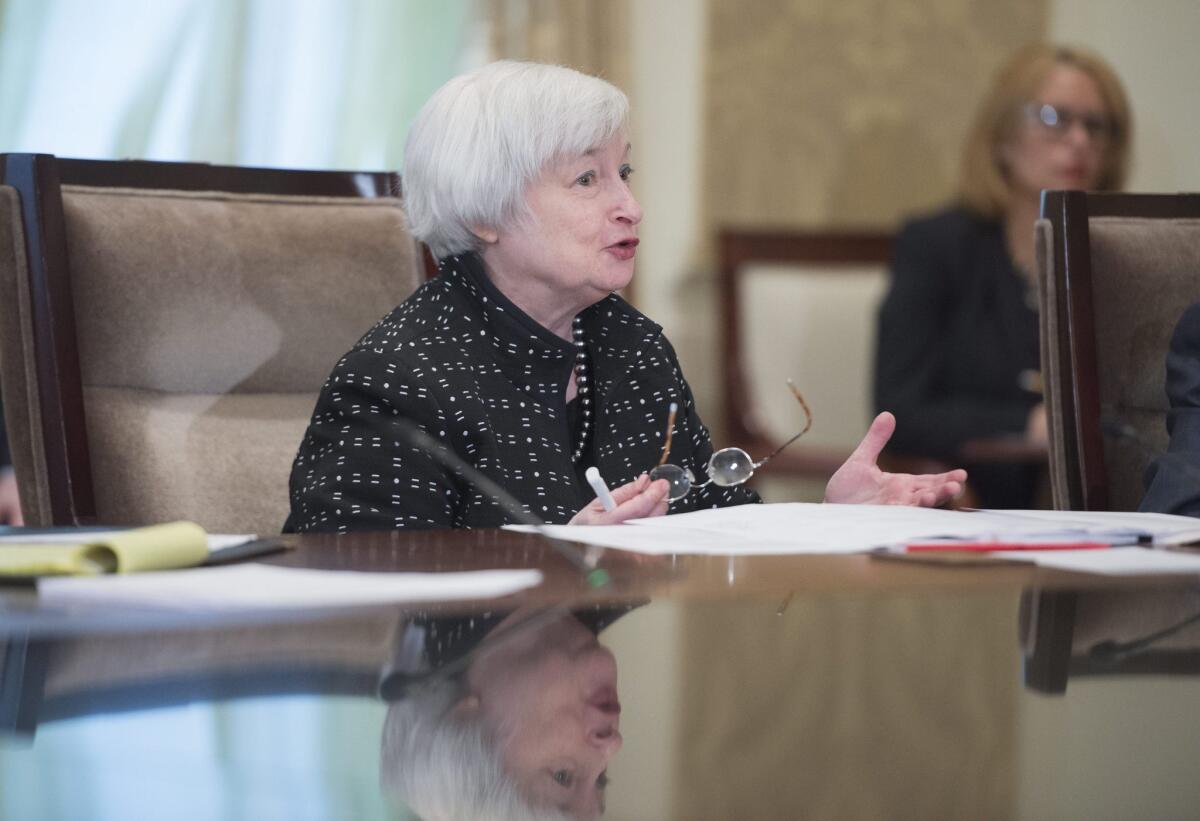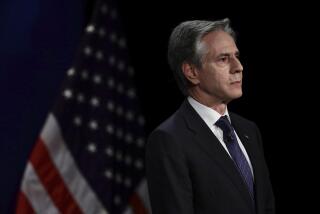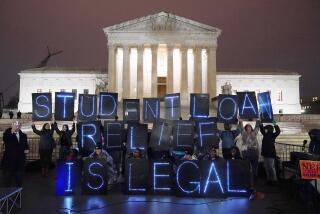Fed moves to bar bailouts of failing firms

U.S. Federal Reserve Board Chairwoman Janet Yellen attends an open meeting of the Board of Governors of the Federal Reserve System at the Marriner S. Eccles Federal Reserve Board Building in Washington, D.C., on Monday.
- Share via
Federal Reserve officials have moved to prevent the central bank from bailing out failing companies, a power it exercised during the 2008 financial crisis.
The Fed governors voted 5-0 Monday at a public meeting to downsize the Fed’s emergency lending powers.
Only broad lending programs designed to revive frozen markets — not loans to individual firms — will be allowed. The Fed spent about $2 trillion on such a program to ease a credit crunch during the financial meltdown, aiming to spark lending to consumers and small businesses.
The 2010 law enacted by Congress overhauling financial regulation required the Fed to impose the restraints. Lawmakers of both parties had objected to the Fed’s emergency aid to several big Wall Street banks and insurance giant American International Group.
“Emergency lending is a critical tool that can be used in times of crisis to help mitigate extraordinary pressures in financial markets that would otherwise have severe adverse consequences for households, businesses and the U.S. economy,” Fed Chair Janet Yellen said before the vote.
Yellen noted that to replace rescue loans to individual companies, the 2010 law outlines procedures for failing big financial firms to go through bankruptcy proceedings.
The new rule takes effect Jan. 1.
For any emergency lending that the Fed does make, interest rates must be set high enough to encourage repayment as fast as possible.
The Fed adopted some of the restrictions proposed in legislation by a bipartisan group of lawmakers led by Sens. Elizabeth Warren, D-Mass., and David Vitter, R-La.
Vitter called the Fed’s action “the first real acknowledgement from the Fed that it needed to do more to curtail its own bailout authority.”
“American taxpayers should never be on the hook to bail out financial institutions that make unwise and risky bets,” Vitter said in a statement.
Rep. Jeb Hensarling of Texas, a conservative Republican who heads the House Financial Services Committee, said the Fed’s rule doesn’t go far enough because it still allows emergency lending at the Fed’s discretion.
“‘Too big to fail’ is unfortunately alive and well, and this rule from the Federal Reserve doesn’t change that,” he said.
The issue of limits on the government’s power in responding to financial catastrophe came to the fore in an unusual legal case over the Fed’s $85 billion bailout in September 2008 of then-teetering AIG. Former AIG Chairman and CEO Maurice Greenberg sued the government, asserting that the terms of the federal rescue loan were unfairly punitive.
The bailout violated the Constitution’s Fifth Amendment by taking control of AIG with 80 percent of the stock without “just compensation,” Greenberg’s suit alleged. He demanded some $40 billion in damages for himself and other AIG shareholders from the government.
The government insisted that its actions in the AIG bailout were legal, proper and effective, and that the terms were as tough as needed to protect taxpayers from the risk of AIG failing to repay the loan.
Following an eight-week trial in fall 2014 in the U.S. Court of Federal Claims, the judge handed Greenberg a partial victory. He ruled in June that Greenberg’s allegation of excessively strict terms was valid, but rejected the former AIG CEO’s demand for damages.
More to Read
Inside the business of entertainment
The Wide Shot brings you news, analysis and insights on everything from streaming wars to production — and what it all means for the future.
You may occasionally receive promotional content from the Los Angeles Times.










